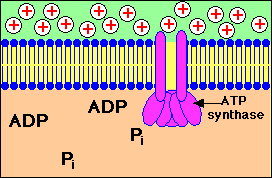 |
 |
The schematic diagram above illustrates a bacterial cell. In the animation, watch as H+ ions accumulate just outside the cell membrane whenever NADH is made from oxidation reactions, generating a proton gradient (upper image). Protons re-enter the cell through the ATP synthase complex, generating ATP (lower image).Key points:
- Protons are first translocated across the membrane, from the cytoplasm to the periplasmic space, as a result of electron transport resulting from the formation of NADH by oxidation reactions. (See animation of electron transport if you don't understand this step.) The continued buildup of these protons creates a proton gradient.
- ATP synthase is a large protein complex with a proton channel that allows re-entry of protons.
- ATP synthesis is driven by the resulting current of protons flowing through the membrane:
ADP + Pi ---> ATP
Return to Lecture Index